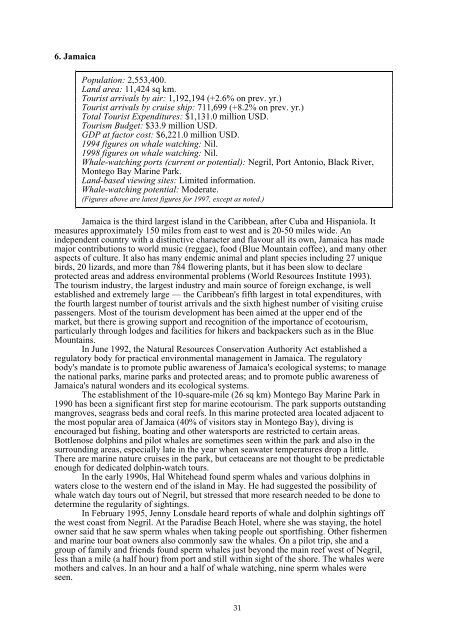The Potential of Whale Watching in the Caribbean: 1999+
The Potential of Whale Watching in the Caribbean: 1999+
The Potential of Whale Watching in the Caribbean: 1999+
Create successful ePaper yourself
Turn your PDF publications into a flip-book with our unique Google optimized e-Paper software.
6. Jamaica<br />
Population: 2,553,400.<br />
Land area: 11,424 sq km.<br />
Tourist arrivals by air: 1,192,194 (+2.6% on prev. yr.)<br />
Tourist arrivals by cruise ship: 711,699 (+8.2% on prev. yr.)<br />
Total Tourist Expenditures: $1,131.0 million USD.<br />
Tourism Budget: $33.9 million USD.<br />
GDP at factor cost: $6,221.0 million USD.<br />
1994 figures on whale watch<strong>in</strong>g: Nil.<br />
1998 figures on whale watch<strong>in</strong>g: Nil.<br />
<strong>Whale</strong>-watch<strong>in</strong>g ports (current or potential): Negril, Port Antonio, Black River,<br />
Montego Bay Mar<strong>in</strong>e Park.<br />
Land-based view<strong>in</strong>g sites: Limited <strong>in</strong>formation.<br />
<strong>Whale</strong>-watch<strong>in</strong>g potential: Moderate.<br />
(Figures above are latest figures for 1997, except as noted.)<br />
Jamaica is <strong>the</strong> third largest island <strong>in</strong> <strong>the</strong> <strong>Caribbean</strong>, after Cuba and Hispaniola. It<br />
measures approximately 150 miles from east to west and is 20-50 miles wide. An<br />
<strong>in</strong>dependent country with a dist<strong>in</strong>ctive character and flavour all its own, Jamaica has made<br />
major contributions to world music (reggae), food (Blue Mounta<strong>in</strong> c<strong>of</strong>fee), and many o<strong>the</strong>r<br />
aspects <strong>of</strong> culture. It also has many endemic animal and plant species <strong>in</strong>clud<strong>in</strong>g 27 unique<br />
birds, 20 lizards, and more than 784 flower<strong>in</strong>g plants, but it has been slow to declare<br />
protected areas and address environmental problems (World Resources Institute 1993).<br />
<strong>The</strong> tourism <strong>in</strong>dustry, <strong>the</strong> largest <strong>in</strong>dustry and ma<strong>in</strong> source <strong>of</strong> foreign exchange, is well<br />
established and extremely large — <strong>the</strong> <strong>Caribbean</strong>'s fifth largest <strong>in</strong> total expenditures, with<br />
<strong>the</strong> fourth largest number <strong>of</strong> tourist arrivals and <strong>the</strong> sixth highest number <strong>of</strong> visit<strong>in</strong>g cruise<br />
passengers. Most <strong>of</strong> <strong>the</strong> tourism development has been aimed at <strong>the</strong> upper end <strong>of</strong> <strong>the</strong><br />
market, but <strong>the</strong>re is grow<strong>in</strong>g support and recognition <strong>of</strong> <strong>the</strong> importance <strong>of</strong> ecotourism,<br />
particularly through lodges and facilities for hikers and backpackers such as <strong>in</strong> <strong>the</strong> Blue<br />
Mounta<strong>in</strong>s.<br />
In June 1992, <strong>the</strong> Natural Resources Conservation Authority Act established a<br />
regulatory body for practical environmental management <strong>in</strong> Jamaica. <strong>The</strong> regulatory<br />
body's mandate is to promote public awareness <strong>of</strong> Jamaica's ecological systems; to manage<br />
<strong>the</strong> national parks, mar<strong>in</strong>e parks and protected areas; and to promote public awareness <strong>of</strong><br />
Jamaica's natural wonders and its ecological systems.<br />
<strong>The</strong> establishment <strong>of</strong> <strong>the</strong> 10-square-mile (26 sq km) Montego Bay Mar<strong>in</strong>e Park <strong>in</strong><br />
1990 has been a significant first step for mar<strong>in</strong>e ecotourism. <strong>The</strong> park supports outstand<strong>in</strong>g<br />
mangroves, seagrass beds and coral reefs. In this mar<strong>in</strong>e protected area located adjacent to<br />
<strong>the</strong> most popular area <strong>of</strong> Jamaica (40% <strong>of</strong> visitors stay <strong>in</strong> Montego Bay), div<strong>in</strong>g is<br />
encouraged but fish<strong>in</strong>g, boat<strong>in</strong>g and o<strong>the</strong>r watersports are restricted to certa<strong>in</strong> areas.<br />
Bottlenose dolph<strong>in</strong>s and pilot whales are sometimes seen with<strong>in</strong> <strong>the</strong> park and also <strong>in</strong> <strong>the</strong><br />
surround<strong>in</strong>g areas, especially late <strong>in</strong> <strong>the</strong> year when seawater temperatures drop a little.<br />
<strong>The</strong>re are mar<strong>in</strong>e nature cruises <strong>in</strong> <strong>the</strong> park, but cetaceans are not thought to be predictable<br />
enough for dedicated dolph<strong>in</strong>-watch tours.<br />
In <strong>the</strong> early 1990s, Hal Whitehead found sperm whales and various dolph<strong>in</strong>s <strong>in</strong><br />
waters close to <strong>the</strong> western end <strong>of</strong> <strong>the</strong> island <strong>in</strong> May. He had suggested <strong>the</strong> possibility <strong>of</strong><br />
whale watch day tours out <strong>of</strong> Negril, but stressed that more research needed to be done to<br />
determ<strong>in</strong>e <strong>the</strong> regularity <strong>of</strong> sight<strong>in</strong>gs.<br />
In February 1995, Jenny Lonsdale heard reports <strong>of</strong> whale and dolph<strong>in</strong> sight<strong>in</strong>gs <strong>of</strong>f<br />
<strong>the</strong> west coast from Negril. At <strong>the</strong> Paradise Beach Hotel, where she was stay<strong>in</strong>g, <strong>the</strong> hotel<br />
owner said that he saw sperm whales when tak<strong>in</strong>g people out sportfish<strong>in</strong>g. O<strong>the</strong>r fishermen<br />
and mar<strong>in</strong>e tour boat owners also commonly saw <strong>the</strong> whales. On a pilot trip, she and a<br />
group <strong>of</strong> family and friends found sperm whales just beyond <strong>the</strong> ma<strong>in</strong> reef west <strong>of</strong> Negril,<br />
less than a mile (a half hour) from port and still with<strong>in</strong> sight <strong>of</strong> <strong>the</strong> shore. <strong>The</strong> whales were<br />
mo<strong>the</strong>rs and calves. In an hour and a half <strong>of</strong> whale watch<strong>in</strong>g, n<strong>in</strong>e sperm whales were<br />
seen.<br />
31
















